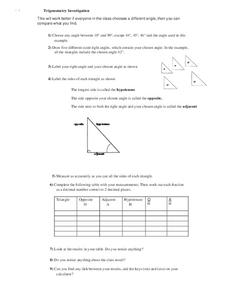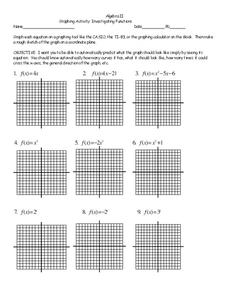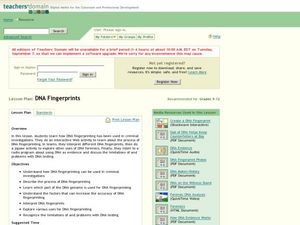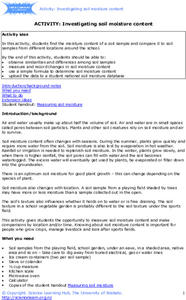Curated OER
Measuring Relative Humidity: A Psychrometer
In this scientific investigation worksheet, learners follow the provided procedures to examine the temperature reading of wet and dry thermometers and then respond to 5 questions.
Curated OER
pH: Acids and Bases
In this scientific investigation worksheet, students follow the provided procedures to examine the pH levels of acid and bases and then respond to 1 short answer question.
Curated OER
The Strength of Shapes
In this scientific investigation worksheet, students follow the provided procedures to examine the strength of shapes and then respond to 4 short answer questions.
Curated OER
Valentine Science Blood Types
Students explore blood types. In this science investigation lesson, students participate in a classroom simulation that replicates a blood transfusion so that students may note how the 4 blood types interact.
Curated OER
Making a Crater
Students examine the characteristics of craters. In this crater lesson, students discover how meteors form craters on planets and moons as they make their own craters and respond to observational questions regarding the...
Curated OER
Incredible Iceboats
Students explore the concept of floating objects (ice). In this floating lesson, students conduct an investigation in which they hypothesize about the time that an ice boat will last floating in water. Students record their...
Curated OER
Ocean Currents
Young scholars determine how water and wind affect ocean currents. In this science investigation lesson, students follow the provided steps to enable them to consider how explorers may have used ocean currents to their advantage.
Curated OER
Studying Soils on South Penquite Farm
Young scholars investigate soil depth. In this studying soils instructional activity, students visit South Penquite Farm and collect samples. Young scholars record their data and graph results.
Curated OER
Trigonometry Investigation
In this math learning exercise, students use the sheet to conduct an investigation to find the trigonometric ratios using opposite and adjacent sides to see how they are related to each other.
Curated OER
Investigating Functions
In this investigating functions instructional activity, 11th graders solve and complete 18 different problems. First, they graph each equation on the graphs shown. Then, students make a rough sketch of graph on a coordinate plane. They...
Curated OER
DNA Fingerprints
Students study DNA fingerprinting and how it is used in criminal investigations. In this DNA activity students interpret DNA fingerprints, explore the uses for fingerprinting and see the limitations of DNA testing.
Curated OER
Prairie Voices: Community Development, Investigating Local History
Students investigate local history. In this research skills lesson, students examine historic landmarks, tax records, fire maps, town plans, historic photographs, newspapers, and other primary sources to learn about local communities in...
Curated OER
Investigating Pythagorean Triples
Students investigate and solve Pythagorean triples. In this geometry lesson, students find the missing sides and angles of a right triangle. They graph right triangles and move the sides around to create different angles.
Curated OER
Investigating the Pythagorean Triples
Students investigate the Pythagorean triples. In this geometry lesson, students solve for different parts of a right triangle. They identify the missing side or angle using the pythagorean theorem.
Curated OER
Investigating Linear Equations Using Graphing Calculator
Students investigate linear equations using the Ti-Calculator. In this algebra lesson, students graph lines and identify the different quadrants on a coordinate plane. They identify ordered pairs used to plot lines.
Curated OER
Sand Shakes & Mud Pies: Investigating Sediment
Take a field trip to a location where water and land meet to study patterns of sediment organization in wet habitats: river or ocean beaches, sand dunes, tidal marshes, the edge of a pond, or a woodland stream. Small groups collect pairs...
Curated OER
Portraits, Pears, and Perfect Landscapes: Investigating Genre in the Visual Arts
Students define genre in the visual arts, particularly in Western painting and explain the differences between subject and genre. The genre of a variety of works of art is identified.
Curated OER
Investigating Seasonal Variability in NO2 Concentrations
Students study different formats of data and determine the nitrogen dioxide concentrations. In this seasons lesson students understand the different relationships that NO2 can have.
Curated OER
Floating and Sinking - An Investigation
A simple and effective presentation could be helpful for your young scientists. Learners consider whether or not a piece of wood, glass, cork, brick, and ice will float or sink when placed in water. After the class has made their...
Texas State Energy Conservation Office
Investigation: Insulation
Youngsters compare the heat-holding abilities of three different cans by insulating two with different materials and measuring the temperature change of hot water over a 20-minute period.
Texas State Energy Conservation Office
Investigation: Building a Parabolic-Trough Collector
Amateurs of alternative energy build a mini parabolic-trough solar energy collector and use it to heat water. Temperature is recorded over a three-minute period and the data is graphed and analyzed. Note that in order to paint aquarium...
University of Florida
Investigating the Fungus among Us
What do you call a fungus that writes music? A decomposer! Here, young biologists explore fungus by tasting fungus (blue cheese) to creating art with fungus to playing a board game centered around, you got it, fungus. Surprise...
NOAA
Investigating Sea Level Using Real Data
The news reports on rising sea level, but how do scientists measure this rise? Scholars use NOAA data including maps, apps, and images to work through five levels of activities related to sea level. Each level in the series adds a new...
University of Waikato
Investigating Soil Moisture Content
Class members analyze the water content in soil samples by drying out the samples and taking measurements every minute until all the moisture is gone. Scholars compare the initial weight to the dried weight to calculate the percentage of...
Other popular searches
- Mathematical Investigations
- Scientific Investigations
- Science Investigations
- Field Investigations
- Hands on Investigations
- Designing Investigations
- Math Investigations
- Conducting Investigations
- Class Investigations
- Crime Scene Investigations
- Pythagoras Investigations
- Water Cycle Investigations























